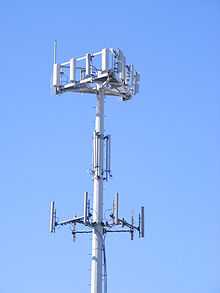Telecom infrastructure sharing

Due to economy of scale property of telecommunication industry, sharing of telecom infrastructure among telecom service providers is becoming the requirement and process of business in the telecom industry where competitors are becoming partners in order to lower their increasing investments. The degree and method of infrastructure sharing can vary in each country depending on regulatory and competitive climate.
Regulatory View
United States
The Federal Communications Commission (FCC), as an independent agency of the United States government, was established by the Communications Act of 1934. As the successor to the Federal Radio Commission, FCC is taking charge of regulating all non-federal government use of the radio spectrum(including radio and television broadcasting), and all interstate telecommunications (broadband, wireless and satellite) as well as all international communications that originate or terminate in the United States.
In 1996, The U.S. Congress passed the Telecommunications Act of 1996, which was later recognised as a watershed of competitive environment of US telecommunication industry. It ultimately terminated the monopoly situation by introducing competition into the market, which was started by the deregulation of infrastructure. As specified in Telecommunications Act of 1996, all incumbent local exchange carriers have the following obligations:
- Interconnection—the duty to provide, for the facilities or equipment of any requesting TCC, interconnection with the LEC network.(Section 251 (c))
- Access to rights of way—the duty to afford access to the poles, ducts, conduits ... at nondiscriminatory rates consistent with (Section 224)
- Reciprocal compensation arrangements—the duty to establish reciprocal compensation arrangements for the transport and termination of telecommunications.(Section 251(b))[1]
For the benefit of sharing infrastructure, new entrants are able to enter the market by sharing (leasing) network without building their own ones.
United Kingdom
The UK telecommunications regulator, Ofcom, states that it "encourages mobile network operators to share masts and/or sites where possible" [2] and the Mobile Operators Association (MOA) has published a paper on the subject.[3] There is some co-operation between networks. Mobile Broadband Network Limited (MBNL) is a joint venture between 3UK and T-Mobile (now EE), and O2 and Vodafone have established a joint team called Cornerstone. The two schemes are different in that MBNL shares antennas while Cornerstone shares sites but not antennas. [4]
Advantages
Infrastructure sharing limits duplication and gears investment toward underserved areas, product innovation, and improved customer service.
Traditionally, telecommunication development shows economy of scale and telecom operator spending has been dominated by considerable investment of technology and infrastructure. Given that such investments are fixed, sunk and irreversible, they represent a high risk factor. Maintaining and upgrading infrastructure make this risk even higher. For example, fixed network operators are migrating to next-generation networks, after most mobile network operators have already deployed the third-generation(3G) infrastructures. Therefore, infrastructure sharing can significantly reduce entrance and development risk.
Infrastructure sharing also has great impact on competition. Market becomes more attractive to new players for decreased entrance barriers. Such players can enrich the competition while investing effectively. By alleviating pressure of network deployment, sharing allows operators to turn their attention to improved innovation, better customer service and eventually better commercial offerings and healthier competition.[5]
Telecom Infrastructure
Basically a cell site consists of electronic (active) and non-electronic infrastructure.
- Electronic infrastructure includes base tower station, microwave radio equipment, switches, antennas, transceivers for signal processing and transmission.
- Non-electronic infrastructure includes tower, shelter, air-conditioning equipment, diesel electric generator, battery, electrical supply, technical premises and easements & pylons that account for nearly 60 percent of network rollout costs. See Base Station subsystem and Base Transceiver Station.[6]
Infrastructure Sharing
Telecom service providers can share infrastructure in many ways, depending on telecom regulatory and legislation.
- Passive Infrastructure sharing is sharing non-electronic infrastructure at cell site. Passive Infrastructure is becoming popular in telecom industry world wide.
- Site sharing includes antennas and mast; this may also hold Base transceiver station (BTS), Node B in UMTS context and common equipment such as Antenna system, masts, cables,ducts, filters, power source and shelter.
- Sharing a mast is called mast sharing.
- Antenna sharing shares an antenna and all related connections (coupler, feeder cable), in addition to passive radio site elements.
- Active sharing is sharing electronic infrastructure.
- Spectrum-sharing (also called Frequency sharing) concept is based on a lease model and is often termed ‘spectrum trading’. An operator can lease a part of its spectrum to another operator on commercial terms. Though this mechanism, along with that of MVNOs, exists in the US, Europe, Singapore and Australia.
- Base station sharing is prospective while each operator maintains control over logical Node B so that it will be able to operate the frequencies assigned to the carrier, fully independent from the partner operator and retains control over active base station equipment such as the TRXs that control reception/transmission over radio channels. Radio network controller and core network are not shared here.
- Radio Network Controller (RNC) sharing represents maintaining logical control over the RNC of each operator independently.
- MSC and Routers sharing or backbone sharing includes sharing switches (MSC) and routers (SGSN) on the operator's fixed network.
- Network Sharing where a network infrastructure is created expressly for the purpose of sharing resources. For example in Sweden 70% of the country is covered by a shared network built as a joint venture between Telenor Sweden (originally Vodafone Sweden) and HI3G (Hutcheson Investor). When a user is in one of the main cities his calls are carried by the native network infrastructure of Telenor or HI3G while outside the cities his call roams onto the shared network provided by 3GIS.[7]
- Geographical Splitting
See also
References
- ↑ Telecommunications Act of 1996, “,” from FCC website
- ↑ http://licensing.ofcom.org.uk/radiocommunication-licences/mobile-wireless-broadband/cellular-wireless-broadband/policy-and-background/site-sharing/
- ↑ http://www.mobilemastinfo.com/images/stories/documents/fact_sheets/site_sharing_b.pdf
- ↑ http://www.mobilemastinfo.com/network-sharing-and-consolidation/
- ↑ Telecom Infrastructure Sharing(Regulatory Enablers and Economic Benefites),, 2007.
- ↑ Sharing telecom infrastructure,,Express Computer,2007
- ↑ 3GIS web site (in Swedish)
External links
- Site Share
- TRAI proposes sharing of telecom infrastructure - The Hindu, April 12, 2007